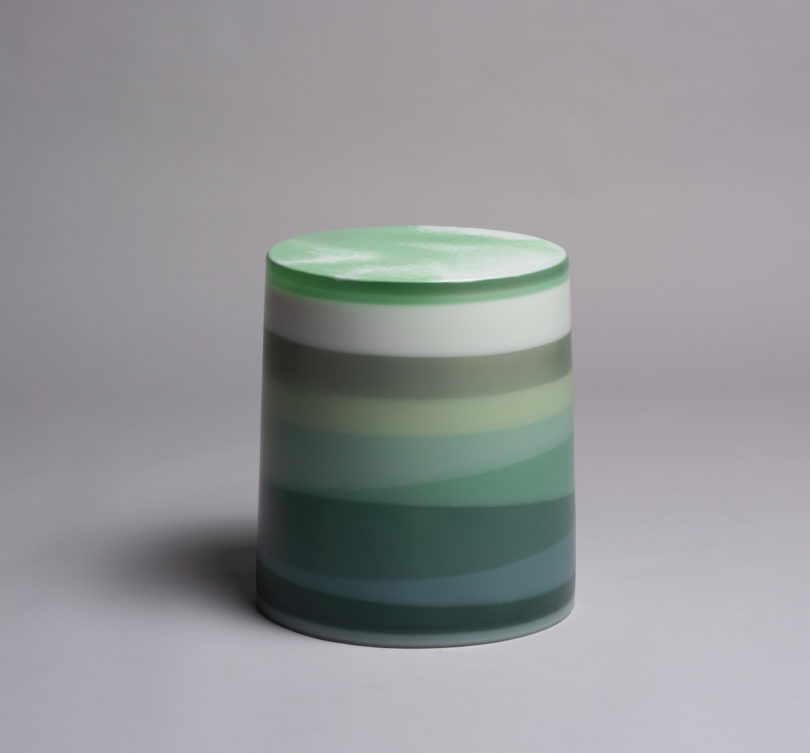At Milan Design Week, larger brands often have their own showroom or dedicated apartment space to sprawl out and give their products a finely decorated backdrop to shine. For smaller designers to gain visibility, there’s Ventura Projects.
Taking up 3500-square-meters over two floors of the industrial BASE Milano building, Ventura Future provides an overview of contemporary projects from a mix of academic institutions and emerging design studios to show the potential for innovative works to address future visions.
Plastic Stone Tiles by Enis Akiev (Germany)- Enis Akiev’s plastic stone tiles are made from lightweight packaging waste. By studying rock forming processes, Akiev came up with a way to develop this post-consumer waste into a natural-looking rock-like tile.
What if instead of an animal-skin carpet there is a tree-skin carpet?
-Sarmite Polakova
Pineskins by Studio Sarmite (Latvia)- Selected as part of Form and Seek’s collective exhibition, Pineskins by Latvian designer Sarmite Polakova is made from pine bark, a by-product of tree cutting. Freshly harvested Pina bark is treated with softeners to transform it into a more pliable material similar to leather. The bark is then enhanced with color pigments and coated with beeswax. Polakova also found that by mixing the leftover bark with pine resin and bioplastics, she can produce a material that is flexible and moldable into various shapes.
A Space Oddity by Andrea Maestri (Italy)- This collection of three big ceramic vases as playful robots has a namesake that references the popular David Bowie song, Space Oddity. There’s a coffee table conceived of as a flying saucer, a metal toy with psychedelic patterns, and a coat hanger that resembles, in the designer’s words, “an alien flower that looks at you with many curious eyes.” The entire collection was made by Italian craftsmen.
Technicolor by Cleverclaire (Korea)- Hee Kyung Sul of Cleverclaire creates furniture from her signature material, epoxy resin. Hee is a fan of the material given its fluidity, transparency and durability. Using different concentrations of epoxy, according to the designer, allows her to create these colorful and unique patterns. The colorful cubic furniture looks delectable, like rainbow layered cakes.
Industrial Craft by Charlotte Kidger (UK)- Kidger’s collection graces the cover image for this article. Her recycled side tables were selected as one of the finalists to exhibit for free at Ventura Future as part of ExpoWanted, DesignWanted’s competition to highlight emerging designers and their projects. Kidger found that the plastic waste streams from CNC fabrication contains abundant volumes of lightweight polyurethane foam dust, a by-product after the milling process. This niche plastic is traditionally left to be incinerated or put in a landfill, so through material exploration, Kidger produced a durable and versatile composite material that is malleable enough to be cast in diverse three-dimensional forms. What was previously discarded now becomes an extremely durable material of value. Kidger used the plastic waste streams from Bakers Patterns, a CNC fabrication company based in Telford.
Cherished by Diederik Schneemann (The Netherlands)- We all know people who have amassed a rather remarkable collection of cherished objects over the years, only to have them relish away in attics or cellars after interest in them has waned. Schneemann invokes these objects again—objects which evoke a certain era or memory or youthful sentiment—as an amalgamation. Smurfs are endowed with a new function—or decorative power.
Insectology: Food for Buzz by Matilde Boelhouwer (The Netherlands)- Matilde Boelhouwer of Atelier Boelhouwer created artificial flowers that flower enduringly to serve as an emergency food source for pollinators. Boelhouwer worked with engineers and scientists to develop 5 colorful, man-made flowers that continuously produce pollen in order to revive insect populations in an ecosystem.
Wanderlust by Leandra Eibl (Italy)- Eibl’s modular, customizable cabinet with acrylic panels in different colors and translucencies lets you adapt your cabinet to either showcase or hide your belongings.
Equilibrium by Jun Murakoshi (Japan)- Murakoshi embraces the simplicity of the single line. His collection, which uses Arakawa grips and wires to establish an equilibrium between tensile strength and gravity, is a fine showcase of “a line as an individual product.” The fine line becomes a fine design object in itself.
from WordPress https://connorrenwickblog.wordpress.com/2019/04/29/mdw19-ventura-projects-gives-the-stage-to-emerging-designers-you-should-know/























No comments:
Post a Comment